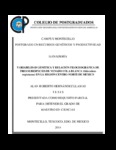| dc.contributor.author | Hernández Llamas, Alán Roberto | |
| dc.creator | HERNANDEZ LLAMAS, ALAN ROBERTO; 360365 | |
| dc.date.accessioned | 2014-04-21T20:57:01Z | |
| dc.date.available | 2014-04-21T20:57:01Z | |
| dc.date.issued | 2014 | |
| dc.identifier.uri | http://hdl.handle.net/10521/2246 | |
| dc.description | Tesis (Maestría en Ciencias, especialista en Ganadería).- Colegio de Postgraduados, 2014. | en_US |
| dc.description.abstract | El venado cola blanca es la especie de mayor importancia en la actividad cinegética en México. En el país se distribuyen 14 de las 38 subespecies reportadas para Norte, Centro y Sur América, a pesar de esto existe poco conocimiento acerca de su diversidad genética. El objetivo de esta investigación fue determinar y describir la variabilidad genética de las subespecies O. v. miquihuanensis, O. v. couesi y O. v. mexicanus en la región Centro-Norte de México por medio del uso de un fragmento de la Región Control (D-Loop) del ADN mitocondrial. Se colectaron 67 muestras de tejido muscular, cartílago auricular u órganos; 4 de O. v. miquihuanensis, 43 O. v. mexicanus, y 20 O. v. couesi de Zacatecas, Aguascalientes, San Luis Potosí, Morelos y Puebla. Se identificaron 51 haplotipos diferentes. Para el establecimiento de las relaciones filogenéticas se utilizaron los métodos de Neighbor-Joining y Máxima Parsimonia con las secuencias del fragmento de 489 pb. La estructura genética y variabilidad fueron calculadas por medio del Análisis de Varianza Molecular (AMOVA) y los índices de diversidad haplotípica (h) y nucleotídica (π). En los resultados de los árboles se observó la separación de la subespecie O. v. mexicanus en un clado y la unión de O. v. miquihuanensis con O. v. couesi en otro. Los análisis de AMOVA resultó una alta diferenciación genética entre las subespecies analizadas (FST = 0.32163, P<0.05). Los niveles de los índices h (0.98598) y π (0.08276) sugieren moderados niveles de variación genética. Con los resultados es posible establecer mejores estrategias de conservación y manejo para el aprovechamiento del venado cola blanca y evitar la pérdida del pool genético original de cada una de las tres subespecies analizadas. _______________ GENETIC VARIABILITY AND PHYLOGEOGRAPHIC RELATIONSHIP BETWEEN THREE WHITE-TAILED DEER (Odocoileus virginianus) SUBSPECIES IN MEXICO. ABSTRACT: The whitetail deer is the species-of greatest importance in hunting in Mexico. Distributed in the country 14 of the 38 subspecies reported for North, Central and South America, despite this there is little knowledge about its genetic diversity. The aim of this research was to determine and describe the genetic variability of the subspecies O. v. miquihuanensis, O. v. couesi and O. v. mexicanus in the Center-North of Mexico by using a fragment of the control region (D-loop) of mitochondrial DNA. 67 samples of muscle tissue, ear cartilage or organs were collected, 4 of O. v. miquihuanensis, 43 of O. v. mexicanus, and 20 of O. v. couesi from Zacatecas, Aguascalientes, San Luis Potosi, Morelos and Puebla. We identified 51 different haplotypes. Methods Neighbor-Joining and Maximum Parsimony for establishing phylogenetic relationships by using sequences of 489 bp fragment were used. Genetic structure and variability were calculated using the Molecular Analysis of Variance (AMOVA) and indices of haplotype diversity (h) and nucleotide (π). In the results of trees subspecies separation was observed O. v. mexicanus in one clade and the union of O. v. miquihuanensis with O. v. couesi in another one. AMOVA analyzes resulted high genetic differentiation among subspecies analyzed (FST = 0.32163, P <0.05). Indices levels h (0.98598) and π (0.08276) suggest moderate levels of genetic variation. With the results it is possible to establish better management and conservation strategies for the use of white-tailed deer and prevent the loss of the original gene pool of each of the three subspecies analyzed. | en_US |
| dc.description.sponsorship | Consejo Nacional de Ciencia y Tecnología (CONACYT). | en_US |
| dc.language.iso | spa | en_US |
| dc.rights.uri | http://creativecommons.org/licenses/by-nc-nd/4.0 | |
| dc.subject | Odocoileus virginianus | en_US |
| dc.subject | ADNmt | en_US |
| dc.subject | Región Control | en_US |
| dc.subject | Diversidad Genética | en_US |
| dc.subject | mtDNA | en_US |
| dc.subject | D-Loop | en_US |
| dc.subject | Genetic Diversity | en_US |
| dc.subject | Ganadería | en_US |
| dc.subject | Maestría | en_US |
| dc.title | Variabilidad genética y relación filogeográfica de tres subespecies de venado cola blanca (Odocoileus virginianus) en la región Centro-Norte de México | en_US |
| dc.type | Tesis | en_US |
| Tesis.contributor.advisor | Clemente Sánchez, Fernando | |
| Tesis.contributor.advisor | Lobato Ortíz, Ricardo | |
| Tesis.contributor.advisor | Tarango Arámbula, Luis Antonio | |
| Tesis.contributor.advisor | Rosas Rosas, César Octavio | |
| Tesis.contributor.advisor | Alcántara Carbajal, José Luis | |
| Tesis.date.submitted | 2014 | |
| Tesis.date.accesioned | 2014-03-05 | |
| Tesis.date.available | 2014-04-21 | |
| Tesis.format.mimetype | pdf | en_US |
| Tesis.format.extent | 1,725 KB | en_US |
| Tesis.subject.nal | Venados | en_US |
| Tesis.subject.nal | Stags | en_US |
| Tesis.subject.nal | Haplotipos | en_US |
| Tesis.subject.nal | Haplotypes | en_US |
| Tesis.subject.nal | Biodiversidad | en_US |
| Tesis.subject.nal | Biodiversity | en_US |
| Tesis.subject.nal | Filogeografía | en_US |
| Tesis.subject.nal | Phylogeography | en_US |
| Tesis.subject.nal | Variabilidad | en_US |
| Tesis.subject.nal | Variability | en_US |
| Tesis.subject.nal | Zacatecas, México | en_US |
| Tesis.subject.nal | Aguascalientes, México | en_US |
| Tesis.subject.nal | San Luis Potosí, México | en_US |
| Tesis.subject.nal | Puebla, México | en_US |
| Tesis.subject.nal | Morelos, México | en_US |
| Tesis.rights | Acceso abierto | en_US |
| Articulos.subject.classification | Variación genética | en_US |
| dc.type.conacyt | masterThesis | |
| dc.identificator | 6 | |
| dc.contributor.director | CLEMENTE SANCHEZ, FERNANDO; 5570 | |


